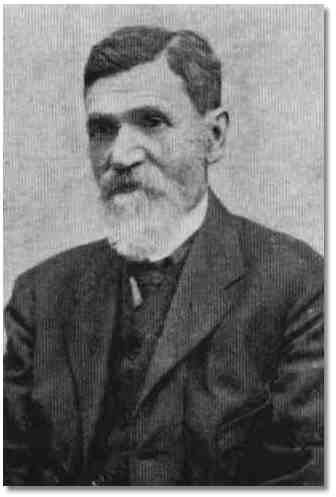Chronological History of the National Institute of Meteorology and Hydrology

Photo 1 SG from 07.02.1887

Photo 2 Spas Vatsov (1856-1928)
February 1st, 1887 The first meteorological station with regular instrumental observations performed by Bulgarians opened in Sofia. Located near the "V. Levski” square in the Botanical Garden of Sofia University “St. Kliment Ohridski”, it was operatonal for over 105 years (until 1992). It was founded by the physics teacher at the First Sofia Boys' High School, and later a professor of astronomy at Sofia University, Marin Bachevarov. From 07.02.1887 the data from the first meteorological station were published in the editions of the State Gazette.
February 20th, 1890 With a prescription from the Ministry of Education, the station in Sofia acquired the status of a Central Meteorological Station (CMS), and Acad. Spas Vatsov became the head of the CMS. This date is considered to mark the beginning of the Bulgarian Meteorological Service.
1891 - Bulgaria and Romania were invited to participate in the International Conference of Directors of Meteorological Services, held in Munich, Germany.

Photo 3 The International Conference of Directors of Meteorological Services, held in Munich, Germany; Spas Vatsov (№ 28)
January 1st 1894 By decree of Prince Ferdinand an independent state institution was established - the Directorate of Meteorology at the Ministry of Education. At the beginning of the same year, the directorate already had 24 meteorological and 60 rain gauge stations. Spas Vatsov had been managing the Directorate of Meteorology for 38 years - from its foundation until the end of his life, February 1, 1928. After the decease of Spas Vatsov in 1928, associate professor Kiro Kirov (1897-1961) was appointed director of the Directorate of Meteorology, who held this position for 22 years until Apr., 1st.1950.
1908 The Directorate of Meteorology was transferred to the Ministry of Agriculture at the request of Spas Vatsov which underlined the orientation towards agriculture.
1912 In parallel with the development of meteorological observations in our country, hydrometric observations were advancing. In 1912, a "Water Department" was established at the Ministry of Agriculture and State Property, which was responsible for the water management in Bulgaria.
1920 The Law on Water Unions was adopted and a water service with a hydrography department was established. Until 1935, the hydrometric network was growing, but the observations were carried out intermittently, which did not allow for more serious practical and research work.
1934 The Directorate of Meteorology was renamed Central Meteorological (and Seismological) Institute (CMI) and was transferred to the Ministry of National Economy.
1949 By Decree № 11 of the Council of Ministers of March 23, 1949, the Hydrographic Service in Bulgaria was established.
1950 By Decree № 2185 of the Council of Ministers of July, 27th 1950 an independent Hydrometeorological Service (HMS) was established in Bulgaria under the auspices of the Council of Ministers. HMS united the following existing services: Central Meteorological Institute at the Ministry of Agriculture, Meteorological Service in the Army (Air Forces) at the Ministry of National Defense, Naval Hydrometeorological Service at the Ministry of Agriculture, Hydrology Service at the Ministry of Electrification and Bioclimatology Service at the Central Insititute of physiotherapy and balneology at the Ministry of Public Health. The first leader of the united HMS was Acad. Lyubomir Krastanov.
March 12th, 1952 Bulgaria became a member of the World Meteorological Organization, represented by the National Hydrometeorological Service.
1953 HMS was renamed Department of Hydrology and Meteorology (UHM) and transferred from the Council of Ministers to the Ministry of Agriculture (Decree № 645 / 03.10.1953). The regional HMS (RHMS) were reduced from seven to four with centres in Plovdiv, Varna, Pleven and Kyustendil. Today these are the branches of the National Institute of Meteorology and Hydrology.
1954 The Institute of Hydrology and Meteorology (IHM) was established - a new structural unit at UHM (Decesion № 13 / 22.01.1954 of the Council of Minsiters).
1962 UHM together with IHM were transferred to the Bulgarian Academy of Sciences (BAS)
July 1st, 1977 UHM became the General Directorate of Hydrology and Meteorology (GUHM).
January 1st, 1990 Unification of GUHM and IHM in order to create a new institute in BAS - Institute of Meteorology and Hydrology (IMH), legal successor of GUHM and IHM (Decession № 15 / 02.11.1989).
August 1st,1991 With Decree № 148 of 25.07.1991 of the Council of Minsiters IMH was renamed into the National Institute of Meteorology and Hydrology (NIMH) at BAS and the funds for the institute were decided to be given separately within the general subsidy provided to BAS. .
August 27th, 2010 A Cooperation Agreement between the Republic of Bulgaria and the European Center for Medium-Range Weather Forecasts (ECMWF) was promulgated.
April 1st, 2014 - The Law on Ratification of the Agreement between the Government of the Republic of Bulgaria and the European Organization for the Development of Meteorological Satellites (EUMETSAT) on the accession of the Republic of Bulgaria to the Convention establishing EUMETSAT was promulgated. NIMH was assigned to fulfill the obligations arising from the Agreement and to represent the Republic of Bulgaria in EUMETSAT.
January 1st, 2019 NIMH from one of the main units at BAS was transformed into the National Institute of Meteorology and Hydrology as a legal entity to the Ministry of Education and Science (§ 1 of the Transitional and Final Provisions of the Law on the state budget of the Republic of Bulgaria for 2019, promulgated SG No. 103 of 13 December 2018).
